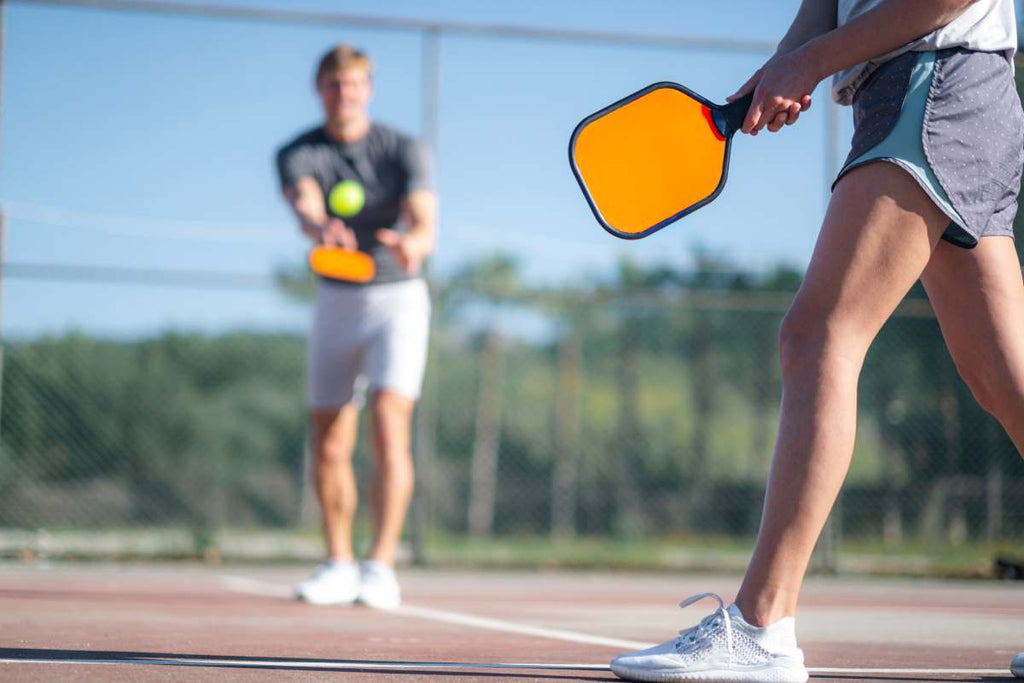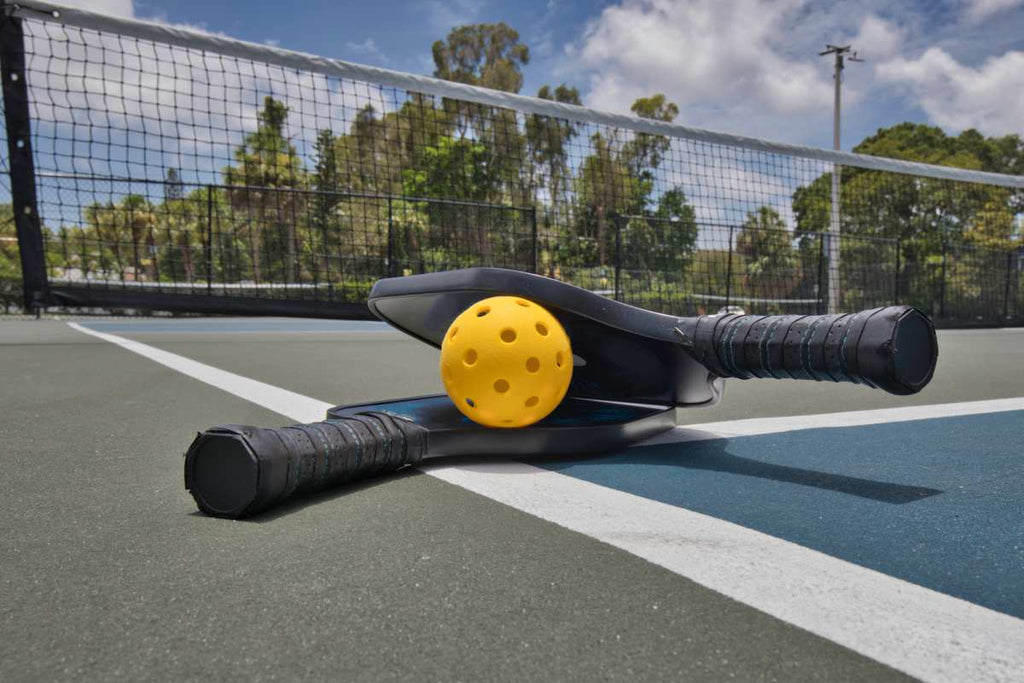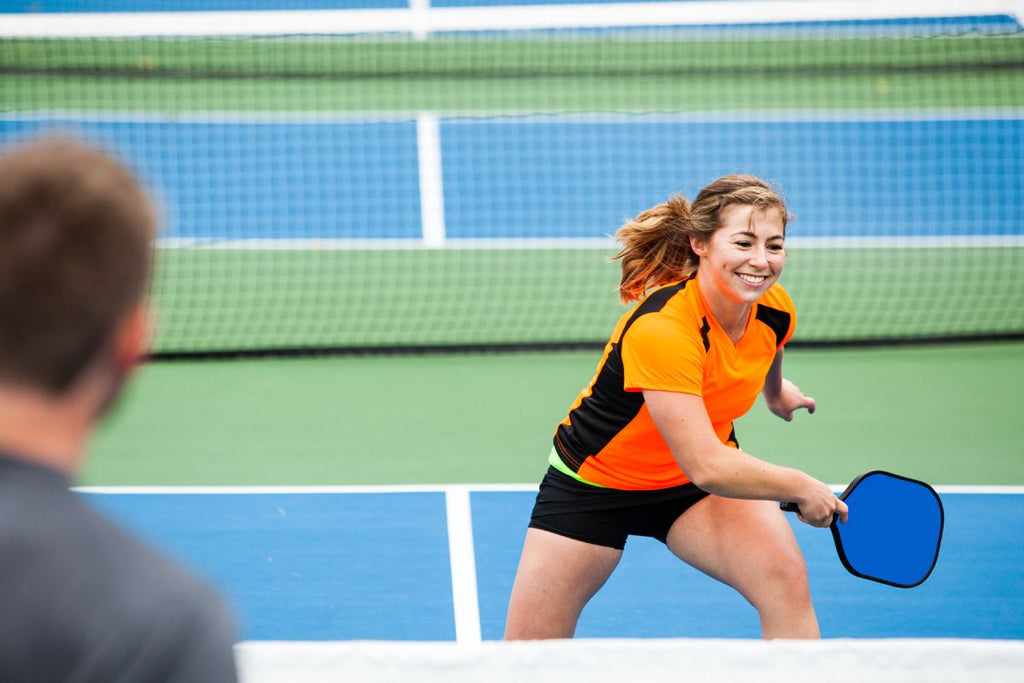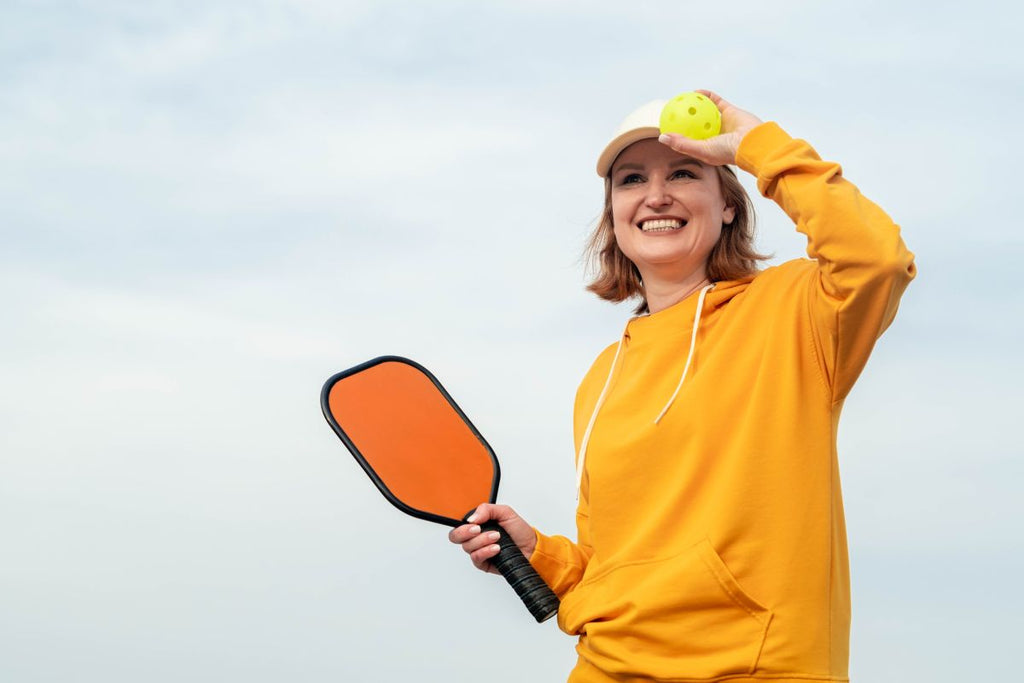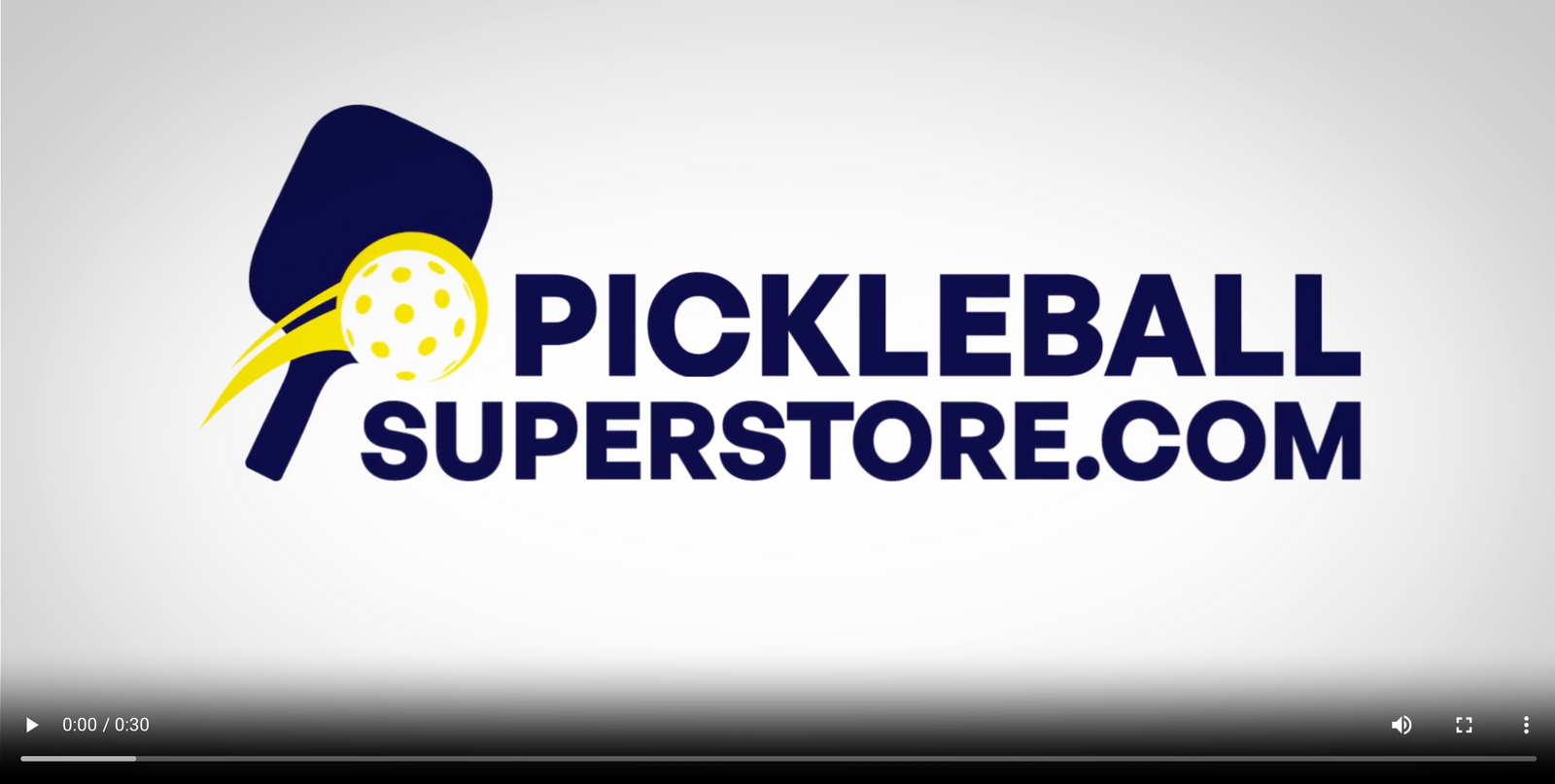TL;DR: Choosing the right pickleball paddle means considering control vs. power, grip size, handle length, shape, weight, thickness, and composition. The guide offers insights for players of all levels, from beginners to professionals, and emphasizes the importance of personal preference in selecting a paddle that suits one’s playing style.
-
Control vs. Power: Determines paddle choice based on personal preference and approach to playing pickleball.
-
Paddle Characteristics: Grip size, handle length, paddle shape, weight, thickness, and composition are crucial to consider.
-
Paddles for Everyone: Learn about options for kids, beginners, intermediate, advanced, and tournament players.
WHAT PICKLEBALL PADDLE SHOULD I BUY?
This question is asked by many players every day. Yes, there are many paddles to choose from, and no, you are not alone if it feels overwhelming.
At Pickleball Superstore, we’re here to help. That's why we’re sharing The Ultimate Pickleball Paddle Buying Guide. Wondering how to play pickleball? This beginner’s guide to playing the sport can help.
This guide can answer plenty of questions about how to choose a good pickleball paddle. But, if you reach the end and are still not sure about which paddle is right for you, get in touch with the team at Pickleball Superstore. We’re happy to answer your questions and offer our assistance.
Now, let’s get started finding the perfect pickleball paddle for your experience level, style of play, and preferences.
To try and make things less confusing, we’ve broken down the key components of purchasing a pickleball paddle along with some links to buy and research specific paddles.
Pickleball Paddle Purchasing Overview
- Pickleball Paddles for Kids (SHOP NOW)
- Pickleball Paddles for Under $100 (SHOP NOW)
- Pickleball Paddles for Beginners (SHOP NOW)
- Pickleball Paddles for Intermediate Players (SHOP NOW)
- Pickleball Paddles for Advanced / Professional Players (SHOP NOW)
- Pickleball Paddles for Spin (SHOP NOW)
- Pickleball Paddles for Power (SHOP NOW)
- Pickleball Paddles for Tennis Players (SHOP NOW)
- Pickleball Paddles for Tournament Play
But before we get into all of these details, here are some basic guidelines to consider as you start your research. To put it simply, there are pickleball players who prefer control, those who prefer power, and those who enjoy playing a balanced style.
The Control vs Power bullets below are generalizations. However, they do help provide some directional guidance for first-time players.
CONTROL VS POWER
Do you tend to like control or power when you play racket sports? Or, if you’re new to using a racket, how do you approach sports and competitive games in general? Sorting yourself into one of the categories below can help you choose a pickleball paddle that’s right for you.
If you’ve seen conversations about 14mm vs 16mm pickleball paddles and didn’t quite understand the difference, these descriptions of different paddle styles can help, too.
-
Most Control = short handle, 16mm core, wide-body shape, carbon surface.
-
Balanced = standard handle, 14mm core, personal preference shape, hybrid surface.
-
More Power = long handle, 13mm core, elongated shape, fiberglass surface.
PICKLEBALL PADDLE PURCHASING OVERVIEW
Each pickleball paddle has six major characteristics to get comfortable with before making a purchase:
- Grip size.
- Handle length.
- Paddle shape.
- Paddle weight.
- Paddle thickness.
- Paddle composition.
Let’s take a closer look at each of these key pickleball paddle qualities.
PICKLEBALL PADDLE GRIP SIZE
There are a variety of pickleball paddle grip sizes: 3 5/8” to 4 1/2”. Their actual sizes depend on the manufacturer and the paddle. Some brands like GEARBOX will commonly use 3 5/8” and 3 15/16” pickleball paddle grip sizes mainly. JOOLA pickleball paddles, on the other hand, commonly come in 4 to 4 1/4” grip sizes.
Be sure to look at the specs of the pickleball paddles as you research your purchase.
Pickleball paddle grip size is a personal preference. You need to experiment with different paddles to find out what feels the best in your hand. The size of your hand can play a big part in deciding which grip size to purchase.
If the grip size is correct, you should be able to place the pointer finger on your opposite hand between your fingertips and your palm. When in doubt, start with a smaller grip size. You can always add a layer or two of overgrip to your pickleball paddle.
TIP: the smaller the pickleball paddle grip size, the more range of motion will exist with the wrist. This can result in more spin and power potential. Be aware though, playing pickleball is not about the wrist when hitting most shots, especially at early skill levels.
PICKLEBALL PADDLE HANDLE LENGTH
In addition to grip size, handle length is definitely worth considering when choosing a pickleball paddle. Some paddles have short handles and others have longer handles. The length of the handle has an impact on overall weight balance and the feel of the pickleball paddle in your hand.
TIP: If you prefer a two-handed backhand, look for handle lengths around 5.5”.
TIP: The longer the handle, the more power and spin you can generate.
PICKLEBALL PADDLE SHAPE
We’ve narrowed down the pickleball paddle shape options to four: wide-body, elongated, round and long-body. A unique variation to the pickleball paddle shape is whether there is an edge guard or if the pickleball paddle is edgeless.
WIDE-BODY PICKLEBALL PADDLES
The wide-body pickleball paddle shape is very common. It tends to have a larger sweet spot and less weight in the head (top) of the paddle. This is a very popular shape for people who are new to pickleball along with those who have a tennis background.
The CRBN2, ONIX Evoke Premier, Wilson Juice and GRUVN-S are some wide-body shaped pickleball paddles. There are many options in this category.
ELONGATED PICKLEBALL PADDLES
Similar to the wide-body shape, the elongated shape is one of the most common pickleball paddle formats. Due to the longer paddle length, this type of shape can carry additional weight balance in the “top” of the paddle.
This shape allows for a bit more court coverage due to it’s length. Many times, elongated paddles also have a longer grip length. That’s great for players who use two-handed backhands.
ROUND PICKLEBALL PADDLES
Round pickleball paddles are not as common as wide-body and elongated pickleball paddles. However, these do exist and have some variation to them, depending on the manufacturer. Feedback about round pickleball paddles is that they can be a bit “faster” at the net.
Again, many times, shape comes down to personal preference. The ProKennex Ovation, DIADEM Icon, and GRUNV-R are some round pickleball shaped paddles.
LONG-BODY PICKLEBALL PADDLES
Long-body pickleball paddles are one of the least common, but there are some available. They are much longer and have a smaller center sweet spot.
The Wilson Juice XL is one of the most used long-body pickleball paddles. You may see this paddle being used more during singles matches, as it gives the player a longer reach for maximum court coverage.
EDGELESS PICKLEBALL PADDLES
For some, edgeless pickleball paddles like the DIADEM Icon, ProKennex models, GEARBOX models or the Engage Omega Evolution Elite are highly preferred. Many players love the feel and maneuverability at the net.
They definitely have a different feel than pickleball paddles with edge guards. Playing with edgeless and edge guard paddles is the only way to really get a feel for the difference and whether you personally prefer them or not.
TIP: The downside to edgeless pickleball paddles is that they are more prone to chipping and cracking due to the lack of protective support.
PICKLEBALL PADDLE WEIGHT
Pickleball paddle weight normally varies from 7.0 oz to 8.6 oz. That may not look like a large range. However, weight makes a big difference in the type of preferred shots a player likes to make.
Pickleball paddle manufacturers will segment their paddles into four groups: featherweight, lightweight, mid-weight / standard weight and heavy weight. Youth pickleball paddles will usually weigh around 5.2-5.5 oz.
FEATHERWEIGHT PICKLEBALL PADDLES (7.0-7.4 OZ)
Featherweight pickleball paddles are quite light to the feel in your hand. Players who prefer lighter paddles tend to enjoy paddle speed and maneuverability. This can help with battles at the net and a touch / dink style game strategy.
Also, featherweight pickleball paddles typically come with a smaller paddle core. This helps reduce some of the paddle weight.
TIP: some more experienced pickleball players purchase featherweight pickleball paddles and add pickleball paddle weights to specific places on the paddle for personal preferences. For instance, certain players have a lighter paddle with weight on the head of the paddle to improve groundstrokes and/or topspin.
MIDWEIGHT / STANDARD WEIGHT PICKLEBALL PADDLES (7.8-8.3 OZ)
Midweight pickleball paddles, also known as standard weight paddles, are the most commonly used paddle weight. This is in part because most pickleball paddle manufacturers make paddles in this weight range. However, it’s also because this range feels pretty normal to players.
One variation in midweight pickleball paddles comes with the shape of the paddle. As mentioned in the section above, the weight balance of a wide-body shape varies from that of an elongated shape. It’s all about weight distribution based on the shape.
Midweight pickleball paddles tend to be balanced in their power, control and stability.
HEAVY WEIGHT PICKLEBALL PADDLES (8.4+ OZ)
Heavier pickleball paddles tend to be used by players who want more power over control. Players who suffer from “tennis elbow” or other tenderness usually move away from heavier pickleball paddles and toward midweight or lightweight paddles.
PICKLEBALL PADDLE THICKNESS
Pickleball paddles can range in thickness from around 11mm to 19mm in size. On the thinner side, paddles include DIADEM Icon and ProKennex models. On the thicker side is the DIADEM Warrior.
Like the other attributes of choosing the best pickleball paddle, the thickness of the paddle does play a role in the feel of the paddle in your hand.
For instance, the CRBN 13mm pickleball paddles provide more power and spin, whereas the CRBN 16mm pickleball paddles provide more control and feel. Players who enjoy “banging” and power will gravitate to the 13mm.
On the other hand, players who play more of a feel and reset strategy have a hard time controlling the 13mm shots. Those shots tend to “pop” off the paddle differently than when the same player uses the 16mm paddle.
The paddle core and thickness affect the performance of the paddle more than the facing of the paddle. So, pay close attention to these elements of the paddle when you’re doing paddle research.
If you are an aggressive player who likes to attack the ball, then you’ll like thinner polymer core paddles. If you prefer control over power, then you’ll like thicker 16mm polymer core paddles. If you want something in the middle, then you’ll like polymer core paddles at or around 14 mm thick.
PICKLEBALL PADDLE COMPOSITION
As you can see, many characteristics will influence the type of pickleball paddle you purchase. Pickleball paddle composition is another critical element to understand – both the core and the surface of the pickleball paddle. Pickleball paddles are described as consisting of wood, aluminum, nomex, polymer, carbon fiber, fiberglass/composite, graphite and a hybrid combination.
NOMEX CORE
The loudest and hardest of core materials, nomex core pickleball paddles are great for a player looking for added power that’s not concerned with the noise level of their paddles. Given so many noise complaints by non-pickleball players, nomex core pickleball paddles are not common.
ALUMINUM CORE
A lightweight and soft material, aluminum core pickleball paddles are a lightweight option that benefits touch players. Again, aluminum core pickleball paddles are not very common as the most common core is plastic / polymer.
POLYMER CORE
Polymer is the most common core material used by brands. Pickleball paddle manufacturers reference the core of the paddle as polymer, poly, polypropylene, or something similar to that. The material is essentially just a very hard plastic.
Polymer is durable, quiet, and offers a good balance of power and touch. That’s why it is the most popular core material.
Not all poly cores are equal in quality. You’ll see $30 paddles with a poly core and $200 paddles with a poly core. The more expensive paddles use a higher quality polymer that doesn’t break down as easily. The result is a more consistent feel across the paddle’s face.
Besides the quality of the polymer, you’ll also see the core material is described in terms of core density. A higher density core uses smaller honeycomb cells, so more of them are packed into the paddle.
The smaller honeycombs gives the paddle a harder, firm feeling and offers more power compared to cores with larger cells. Unless a brand calls out that they are using a higher density core, you can assume they use the standard bigger honeycomb cells.
FIBERGLASS (COMPOSITE)
Fiberglass used to be the most common material for pickleball paddles, but carbon fiber has taken over. Of the three common facing materials listed here, fiberglass offers the most power. You’ll see it called composite sometimes, so just know that composite is the same thing as fiberglass.
Fiberglass is not as stiff as carbon fiber and graphite. It acts as a sort of trampoline that takes the energy from the ball and transfers it right back. Because the material is not as stiff as other options, it will also diminish the size of the sweet spot compared to carbon fiber and graphite.
CARBON FIBER
Carbon fiber is known for having a better feel than fiberglass, but a little less power. It is a very stiff and durable material.
Because the material is so stiff, the energy of the ball at impact is spread throughout the entire face and into the handle. This gives you better feel and a larger sweet spot. However, it will also take some power away because less energy is transferred back to the ball.
GRAPHITE
Graphite is a type of carbon fiber that is a little more cost-effective for brands but plays very similarly to a carbon fiber face. It is also known for having a better feel than a fiberglass face and produces a similar amount of power as a carbon fiber face. From my own testing of paddles, it’s hard to tell the difference between a graphite and carbon fiber face.
HYBRIDS
You’ll see some brands use a combination of the three materials above that will produce performance based on the characteristics of the materials mixed.
PADDLE FACE GRIT
Spin can be a very important part of someone’s game and grit plays a role in the spin a paddle can generate.
There are two main types of grit you’ll see out there. You’ll see spray on or painted grit. This grit has a sand paper like feel to it and often wears out very quickly.
You’ll also see grit that is built into the facing material. This grit tends to last longer and produce more spin.
TIP: over the past few years, we’ve seen a continuous movement to manufacture pickleball paddles with a honeycomb polymer core and a carbon friction surface with built in grit. The carbon friction surface is highly desired by many players for its performance and ability to increase spin of the ball during play.
HOW TO CHOOSE PICKLEBALL PADDLES FOR KIDS
We love seeing kids play pickleball. It’s the future of the sport and honestly, it’s just super fun to watch.
When selecting a youth pickleball paddle for kids, grip size and weight are critical. A heavy paddle will many times cause a “late hit” because it takes a bit longer to move the paddle into a hitting position. An incorrect grip size along with a heavy pickleball paddle can also put extra strain on the youngster’s wrist, elbow and shoulder joints as well.
And, let’s not fool ourselves, the best pickleball paddle for kids also has to look AWESOME! Kids, especially younger ones, tend to notice the aesthetic design of a paddle just as much or more than its qualities in matches.
SHOP PICKLEBALL PADDLES FOR KIDS
PICKLEBALL PADDLES FOR BEGINNERS
As one of the fastest- growing sports in the United States, pickleball is attracting new players every month. As a beginner, choosing a good pickleball paddle you enjoy may take some time. We recommend beginners demo their friends’ pickleball paddles and spend time getting a feel for grip size, weight, shape, and composition.
Because there are so many pickleball paddle options, try a variety of them. Don’t get discouraged if it takes time to zone in on a brand or type you enjoy.
This process is also part of the skill development you’ll need as a new pickleball player. Once you find a brand and/or style you really like,
SHOP PICKLEBALL PADDLES FOR BEGINNERS
PICKLEBALL PADDLES FOR INTERMEDIATE PLAYERS
Intermediate pickleball players have a wide range of skills and styles. This is probably the largest group of pickleball players.
If you're an aggressive player who likes to attack the ball, then you'll like thinnest polymer core paddles. If you prefer control over power, then you'll like thicker 16mm polymer core paddles. If you want something in the middle, then you'll like polymer core paddles at or around 14mm thick.
SHOP PICKLEBALL PADDLES FOR INTERMEDIATE PLAYERS
PICKLEBALL PADDLES FOR ADVANCED PLAYERS
Advanced pickleball players have spent plenty of time playing with paddles and have typically found what they like. Many advanced players add pickleball paddle lead weights, overgrips, and other adjustments to make their pickleball paddle suitable for their playing style. And a portion of advanced pickleball players will earn themselves a pickleball paddle sponsorship – which is always exciting.
SHOP THE BEST POWER PICKLEBALL PADDLES
SHOP THE BEST SPIN PICKLEBALL PADDLES
SHOP PICKLEBALL PADDLES PLAYED BY PROFESSIONALS
PICKLEBALL PADDLES FOR TOURNAMENT PLAY
The USAPA is the main governing body currently for many tournaments, but not all leagues or tournaments will require this certification.
If you’re going to be a tournament pickleball player, look for the USAP Approved logo on the pickleball paddle. It’s never fun to prepare yourself for a tournament to only have your paddle banned by the referee when they conduct a paddle review prior to the first serve of the match.
CHECK OUT ALL OF OUR PICKLEBALL PADDLES
Pickleball Superstore stocks a large inventory of high-quality paddles for all types of pickleball players. We’re here to provide all the equipment you need to start playing or take your game to the next level.
Not sure where to start with choosing a pickleball paddle? View our most popular paddles! Or, use the search feature on our paddle page to narrow down the options and find the best pickleball paddle for you.



